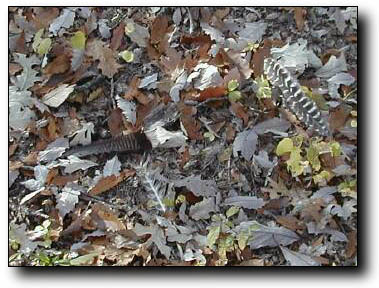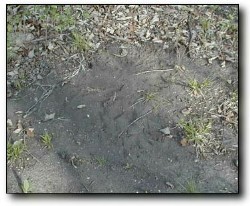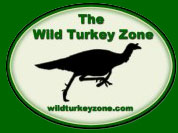|
Location, Location, Location
Scout your hunting
grounds early to pick out prime hunting areas
--
by Rob Ramsdale --
Prime calling locations
are very similar to prime real estate, location is
the key and most of the best spots are very hard to
come by. One of the most important keys to calling
in gobblers is setting up in the right location. But
what makes an area good for calling in a gobbler?
The first rule of thumb for turkey hunters --
It's always easier to call a turkey into a location
it wants to go anyway. Which means, if you
know the area and habits of a gobbler well enough,
you can setup in spots where he is comfortable and
used to traveling through anyway, making your job
of calling that much simpler.
But, how do you find
those perfect calling locations? Here are some general
scouting guidelines to help you find the right calling
location.
Year-round
Scouting
I scout year-round for
turkeys while I am out hunting other game or just
looking around the countryside. Everybody I know also
help keep me informed since it's a well-known fact
I'm a turkey hunting fanatic. I like to keep notes
on the locations I see turkeys and what time of day
I see them. This especially helps during the fall
season when birds are very predictable but it can
also be helpful for the spring season.
If you find an area that
has tons of turkeys using it during the winter, odds
are those turkeys are not moving too far once spring
gets here. The spring migration of turkeys will vary
a lot depending on where you live and what types of
turkeys you are dealing with. The western turkeys,
Merriam's and Rio Grande, will often travel
up to 10 miles or more to get to preferred areas for
spring or winter. The Easterns are generally using
a much smaller range and have most of what they need
for year-round survival in a smaller area of several
square miles.
Pre-Season
Scouting
Scouting 2 to 3 weeks
before you hunt will help you find a general area
that has good numbers of turkeys in the spring. Just
because you saw a huge flock of gobblers using an
area while deer hunting in the winter does not mean
those birds will be there 4 months later in the spring.
Turkeys do not necessarily use the same areas for
both winter and spring and they often migrate from
their winter habitat to their spring habitat right
about when the season begins. Places that are completely
void of turkeys one week, will be turkey heaven a
week later.
In the winter, their
minds are basically on finding high-energy food sources
like acorns and agricultural crops and simply staying
alive. In the spring, they are also looking for the
food sources which are now changing to more insects
and green matter and the hens are also looking for
good nesting habitat. That's why it is important to
do most of your scouting as close to the season as
possible. When I am out doing early scouting, I like
to think like a hen and look for good nesting areas
that have open areas nearby where the hen can take
here poults to feed.
Precision
Scouting
If all has gone well,
you now have a general area located and are trying
to find key areas to increase your chances of success.
Now is the time to begin looking for specific locations
including roosts, strut zones, scratchings and dusting
areas. All of these areas, and the travel routes in
between, are good places for setting up to call in
a gobbler. When you begin this phase of scouting,
a good pair of binoculars and some good boots are
a must since you are going to cover some ground. When
you are out scouting, try to not disturb the turkeys
since seeing you walking around might make them leave
an area. Just be cautious, watch for turkeys and try
to keep out of wide open spaces. Finding roosts and
strut zones can often be done from a distance with
binoculars.
 |
|
Look for
Black and White Barred Wingfeathers and Tail
Feathers to Locate Roost Locations In the Spring
|
Favorite roosting locations
vary according to where you live but generally turkeys
like fairly tall, open trees with good horizontal branches
they can easily stand on to roost. Birds have a unique
physical feature which allows them to sleep in trees
without falling out. When they squat down on their legs,
their toes respond by closing up tightly, locking around
the branch which allows them to sit in trees asleep
at night without fear of falling off their perch.
Usually you won't find a turkey roosted
very far from a water supply and if they can find
a tree situated over running water, that is ideal.
In any area, look first at the large trees with good
horizontal branches near water. In my neck of the
woods, that means large oaks and sycamores and further
west, cottonwoods. If the terrain is hilly, try and
find trees right below the ridge tops that are on
the leeward side of the prevailing winds for that
time of year. If they can, turkeys like to climb up
above the roost on the ridge top and fly down to their
roosting tree. They then will usually glide down below
when they fly down in the morning. Many times the
turkeys in my area will utilize large cedars or occasionally
pines when available to further escape cold winter
winds.
It is also possible to locate roosts
by doing lots of walking through an area and looking
for the large wing and tail feathers which often fall
out when the turkey is flying up or down from the
roost. You can also look for piles of droppings which
can be quite large when a turkey uses a roost tree
consistently. Droppings usually last until they are
rained on which will also help you determine how long
ago turkeys were in the area.
Perhaps the easiest and surest way
to find roost trees is to get there either first thing
in the morning or at sunset and listen for the birds
flying up to roost or calling on the roost. Most people
have heard of the term "roosting a bird"
and this means you have been out that evening and
found out, by owl calling or just listening, the tree
a gobbler has roosted in.
|

|
|
Dusting
Area - A great mid-day setup location
|
Dusting areas are harder
to find but if you run across one they can be unbelievable
good setup areas since turkeys routinely dust during
the mid to late morning hours. Look for an open area
with loose soil where the birds have scratched out a
"bowl" of loose dirt they can sit in and kick
dust over themselves. There are usually a lot of tracks,
droppings and feathers nearby since they do spend quite
a bit of time there during the middle of the day just
loafing. Turkeys are really very clean animals and dusting
keeps them free of mites, ticks and lice.
Another good area to scout for is
the preferred feeding areas of the turkeys.
Generally, the hens are the main ones actively feeding
during the spring and the gobblers just do enough
to get by. Look for open fields, grassy areas or mast
areas that have lots of turkey tracks and scratchings.
Turkeys will often scratch up an entire area if their
is a lot of good mast available. Deer and squirrels
also scratch around in the leaves so it pays to learn
the difference in their scratchings. Turkeys will
almost always pull the leaves to one side only. If
it's a fresh scratching, there will also be scratch
marks left from their toes. Squirrels will often just
make a small circular hole in the leaves to get down
to the acorns. Deer seem to just haphazardly clear
a large area.
Strut Zones are difficult to
find by just walking through an area unless you can
consistently observe a gobbler strutting and gobbling
in the same locations every day. If you don't actually
see the bird strutting, you can sometimes find the
strut marks left by the gobbler's wing tips. These
will show up as two irregular scratch marks about
a foot apart and several feet long that are often
visible if the bird is strutting on bare ground or
maybe a sandbar along the creek/river.
Probably the most important tool in
scouting is your ears. Listen for gobbling birds,
yelps etc. that tell you there are turkeys in the
area. You won't often see turkeys while scouting since
they probably see you first but you should always
be able to hear them if they are in the area.
 Also,
during your precision scouting, make notes on a topographical
map or an overhead satellite image of the property.
Keep track of the roosts you find, any strut zones
or dusting areas and the preferred feeding areas of
the turkeys. Mark down all of the obstacles present
on the property including creeks, fences, thick brush,
steep hills or cliffs; anything that might keep a
gobbler from coming into your setup. Also,
during your precision scouting, make notes on a topographical
map or an overhead satellite image of the property.
Keep track of the roosts you find, any strut zones
or dusting areas and the preferred feeding areas of
the turkeys. Mark down all of the obstacles present
on the property including creeks, fences, thick brush,
steep hills or cliffs; anything that might keep a
gobbler from coming into your setup.
The Internet is a great resource for
turkey hunters. Especially if you are traveling to
hunt a new location. If you can find the topographical
maps and a matching satellite image of the land you
are going to hunt, it is possible to "scout"
a location fairly well before you actually see it
in person. There are a couple of good
spots on the Internet that provide topographical maps
and overhead satellite photos for most areas of the
country.
TerraServer - Topo Maps and Satellite Photos
TopoZone.com
- Topographical Maps
Picking
Your Tree
After doing some in-depth
scouting, you now know a lot about the turkeys in
the area such as where they roost; where some of the
strut zones are; and where they like to feed. You
now must pick a spot to hunt given the time of day
since you already should know the general habits of
the turkeys. For example, if you are hunting early
morning, get to a location by the gobbler's roost
in the general area he flies down to. Or you might
pick instead, a favorite field or open area he heads
to first thing to do his strutting and gobbling.
One of the most intriguing
aspects of hunting gobblers is each turkey hunting
situation is unique. But, if you scout well and learn
the turkeys' habits, the odds will be further in your
favor when hunting season comes along. Also, once
you learn an area well, those favorite strut zones,
roosts etc. will be used year after year as long as
the habitat stays the same. I've consistently killed
turkeys in the same strut zone area year after year.
And, don't give up on an area once you kill a turkey
there. Most often, another bird will move right in
and use basically the same key locations as the previous
gobbler. After awhile, these prime turkey locations
will become more apparent to you even when you are
hunting an unknown area.
Turkeys in the spring
can be very unpredictable but the point is,
if you know the area and the turkey's habits well,
setting up and calling one in can be made much easier.
|

